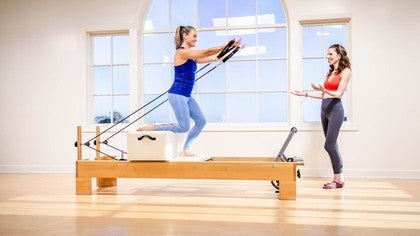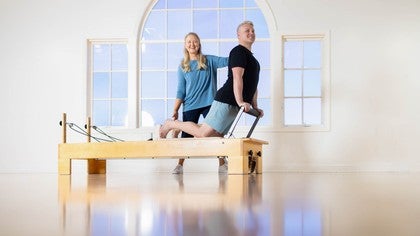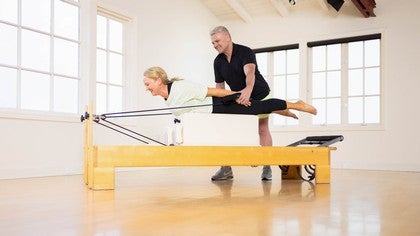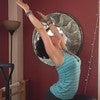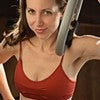Description
If you would like to take the first Stability Reformer that Mariska mentions, you can find it here.
About This Video
Transcript
Read Full Transcript
Hey, Emma. And I'm here with Chandra. It's gonna be my student today. One of my more popular classes from a couple of years ago, was a stability reformer workout. So, we use the small ball for that one, but we're just going to do some stuff, in this class that challenges your stability, sometimes by moving one limb and not the other limb, and we'll just kind of throw in some more balance challenge exercises, but not like huge crazy balance challenges. So we're gonna start with a little bit of warm ups. So, Chandra, if you wanna come to kneeling on the reformer, and you're just gonna bring your hands to the carriage. And so your knees are right up against the shoulder rest. We're gonna actually use this as our opportunity to do, like, a little bit of a cat stretch, but a more engaged cat stretch.
So go ahead and let your back kind of drop down. And then I want you to pull yourself out the tiniest little bit. Just not with your knees, with your arms. Because what I want you to feel is just that connection between your upper body and your lower body. Now move the carriage by tilting your tailbone under.
Don't think about your knees moving. Think about your tailbone moving. Good. And then you can untuck your tailbone and then give your arms like a little teeny break. So we start by just engaging the upper quadrant a little bit. Try to differentiate, leave your head where it is.
So try to differentiate moving your tailbone without moving anything else. And it's actually that tucking under of your tailbone that's going to move the carriage and then bring yourself back. We'll do a couple more like that. So pulling forward, and she's doing a good job of keeping her shoulders where they should be. So her shoulder blades are, like, flat on her back. I have the tendency to, like, really push my arms forward, but she's doing a nice job of keeping her back flat in this position, except for that little teeny talking, you should feel your abs here.
And I think it's, like, so easy in this exercise that we just end up pulling in with our knees and not thinking about can we move with our spine, which is what we're trying to do here. Okay. Give yourself a little teeny break by coming in. We're gonna take one leg back, pick a leg, pick your favorite leg. That leg's coming back, and we're just gonna let that leg lift up. So it's hovering. And then we're gonna do a little pull with your arms to go forward for 2 and then back for 2.
Good. And forward for 2. And back for 2. Nice. And forward for 2. And back for 2. Let's do a couple more like this.
Forward and back and forward and back. Let your right hand kind of slide down towards your right hipsum, and you're gonna bring your left hand to the headrest. So you're in this kind of offset position. Let your right hip open up a little bit and then see if you can give yourself a little bit of a pull with just your right arm and then return. Good little pull with your right arm and return. Little pull with your right arm, and return will do 2 more like this.
And what I like about doing stuff like this is it makes you pay a lot of attention to what you're doing because it's weird. And when it's weird, your brain is like, what is happening and how can I negotiate myself around this bizarre position that Marisca has put me in? Go ahead and lower your right knee down. So now we'll switch legs. So we're gonna start with just the regular pulls with your, left leg back. I'm forty eight years old, and one of these days I'm gonna learn my left from my right.
I still have hope. Pulling forward. So this is really, at this point, kind of arm work. And one more like this. And then you're gonna let that left hand slide down, like, sort of towards your hip, bring your right hand onto the headrest open your hip a little bit, and then we're gonna do a tiny little pull from here. So we're on, like, a half spring.
You might even wanna go a quarter spring for this if it it feels like kind of aggressive. Like, you can always make it a little bit lighter. Well, you actually can't make it, but so much lighter. You can only make it as light as your reformer will allow. Let's do one more here and then go ahead and make your way all the way back down from that. Go ahead and have your hands on the headrest and then tuck your tailbone under. Be light with the headrest.
And then I want you to actually see if you can lift the headrest up a little bit as you tuck your tailbone under. Good. And then lower it back down. And extend your spine. And, again, tilting your tailbone under, see if you can keep your lift going And you're gonna do that as much as possible without too much of a lean back. Obviously, there's physics, and we have to, like, create space to be able to do that movement. We'll call this the last one like this.
Good. And then go ahead and lower that down. We're gonna do some, supine stuffs to go ahead and lay down on your back. Now we're gonna be doing footwork. I like to not make a lot of spring changes, so we're gonna do two reds to start. You could also do, you know, obviously a lot heavier if a lot heavier is where your heart and soul are. I'm head rest down because we're gonna be doing some hips up variations.
So go ahead and have your legs on your feet where you wanna put your feet, reach your arms up towards the ceiling. And then as you press out, one arm is going to go out to the side, and the other arm is not and then go ahead and come in, it's going to come back. Then switch to your opposite arm goes out and then come back in. Reach with your right arm and come back in and reach with your left arm. So right now she's kind of coming to a t.
So let's lower that t down. So when you go out, you're like 45 ish, reaching out, good, and come back in. Reaching out and come back in nice and reaching out and come back in. Probably you wanna be more on where your heel and arch come together because it's just gonna be more comfortable because we're gonna do some hip lifts. So trying that to move the carriage, press into your feet, lift your hips up, And then you're gonna keep your arms where they are, and you're going to open your knees.
So right knee opens out to the side. Only as far as you don't feel like you're gonna tip yourself over and then bring it back to center. Left knee opens out to the side. Good and back to center. Open your right knee and close.
Open your left knee and close, we're gonna add the opposite arm. Right knee left arm. Good. And close, left knee right arm. And close. And you can make these, like, micro movements, like, an inch movement. You can make it bigger.
But watch how much when you open your hip out, how does the pressure feel in your shoulder blades? Like, do you feel like you're really having to stabilize through that part of your body, that would be a logical place where you're stabilizing. How do you feel in your feet? Pay attention to how all of these different parts of your body are helping you make a weird movement happen. Do one more like this and then go ahead and lower yourself all the way back down. I think we're good for, legs and straps at this weight. So, go ahead and get your legs into the straps however you like to get in them.
Flexible people like to get in them this way. Less flexible people like meat like to push the thing all the way straight. Okay. So we're just gonna go ahead and start with some just regular frogs. Because that's always a nice way to start legs and straps. Go ahead and lift your arms up towards the ceiling now, and then turn them so your palms are facing towards each other.
Now next time your legs are out, you're gonna leave them there. Lift your legs up to about 90 degrees, and I'm gonna say whatever your 90 degrees which is where your legs can be up in the air. It does not feel like an extraordinary hamstring stretch. It might feel like a little bit of a hamstring stretch. Without moving the carriage, right foot opens out to the side and then come back to center.
And then stay on the right. Little trick. When the carriage starts moving, it's probably because you are going to a too much of a range of motion. So that kind of coming back in and see how you're kind of pushing into it to try to get your leg back in the same place. Do a little bit smaller range of motion when you're doing that. Good.
Now at the same time, you're moving your right leg I want you to bend your left elbow. Yep. And then reach it up. We're gonna do 3 like this. And then last one like this, Good. And then we'll switch legs.
So your opposite leg opens out. Your top leg that you're not moving leg is sort of you're trying to keep yourself honest leg, the more you have the range of motion, the more you're gonna start to feel the pressure changes in your back. So those are your proprioceptors. So you're gonna see, do you feel heavier on your sacrum on this side? Do you really feel like your one shoulder is digging into the mat to help you stabilize here? Those are totally normal find great wonderful things to happen, but you can try to minimize the pressure changes, and that's gonna make the exercise actually a lot harder. And it's gonna make your range of motion smaller.
So on this next one, when you open out, try not to let any pressure change happen in your shoulder girdle. So make it feel exactly the same from the beginning to the end. And I don't know if you can tell, but her range of motion is a little bit smaller on that one. Now go ahead and just lower your legs down. We're gonna say to about 60 degrees, externally rotate your legs a little bit more. Bend your right knee and then let your left leg lift up so the tension in the strap stays the same. Good.
And then pressed him and then switched. So it's sort of like a Peter Pam, but not really because we're staying a little bit more close. Lifting up and try not to lose that strap tension. So on this one, feel what you feel in your feet. Right? So the strap feels a certain way in the soul of your foot, you wanna keep the strap feeling that way the entire time.
Good. Let's do one more each side. And you might be good staying on this spring weight because I'm right here. I'm gonna make this a little bit lighter for her. So go ahead and take one foot out of the strap and just come in enough that I can swap your spring out. So we're just gonna do a spring in a little bit.
So I have, like, a red yellow, but, you might be good on 2 reds. We're not gonna be here for very long. So go ahead and have your, right leg and tabletop. Your left leg can be reaching up towards the ceiling. And then you're just gonna cross your leg over your other leg.
Like, you're just you're having a you're having a moment. Okay. We're gonna take this shape and we're gonna try to do a little bit of a rollover with it. Bend your right knee a little bit more for me so it's like right Okay. You're gonna try to stay even as you go up and back, and then lower yourself back down. Lifting up and back.
Good. And lower back down. Now we're gonna get a little fancier on this next one. So as you go up and back, if your leg starts here, you're gonna do a little open close. Without feeling like that pressure changes and you're tipping to one side. So start with your leg more parallel. Go up and over. Sassy little knee out knee in, and then lower back down.
Good. We'll do 2 more of this. So we're going up and over, knee out and in, and lower back down. And one more like this up and over, knee out, knee in, and then slowly lower it all the way back down. You can untangle your legs so you can bring one leg. I usually just go to the foot bar to switch the straps.
Sometimes it's like, where's the foot bar? There is the footbar. So you can go ahead and switch which leg, which leg has the strap and then go ahead and we'll have that leg go up. The other leg kind of cross is over. So first, we're just gonna start taking that shape up and over, trying to come in a little bit more. So thinking towards the stopper. Nice. And then lower it back down.
Good in again coming in towards the stopper. Nice and lower it back down. Up and over, then we're gonna do the sassy knee. So when he goes out decide, we can do it on the next one. So as you go up and over, you start more parallel. When the Sassy knee goes out to the side, what you're trying to do is not feel a big torque in your upper body. Right? You want like, that leg should be able to move independent of anything else moving.
But obviously your brain has to organize what's happening in all the rest of your body to, like, stabilize. Right? Ideally, stability is reflective, and we don't have to, like, really think about it. But challenging it in weird ways, can sometimes, like, turn on the parts of our brain that think about these things and then make our balance better as we go through our regular daily life and trip over the sidewalk We'll call this the last one. And then go ahead and we'll slowly lower down. You can take this strap off, and then you're gonna make your way kneeling. I think a blue spring is where I would be I would be happy in this exercise and a blue spring. So it's kind of like some single arm stuff, and then we're gonna be doing like a side kick variation.
I have a student, which is great because I hate sidekick so much. So you never see me do a sidekick. When I have students, they do sidekicks, so little don't tell anyone. Okay. So we're gonna start kneeling on the carriage facing towards, the camera. And then I want you to take the strap that's closer to you.
And then walk yourself out so you're basically in the middle of the carriage. And then pull the strap forward so that it's right in front of your chest without, changing the fact that it's, like, right in front of your chest, like, right at your sternum, you're just gonna reach your arms forward. Carriage might move and then bend your elbows. Could reach your arms forward. Nice. And Benjure Elvis.
Reach forward. Elbows bend reach forward. Elbows bend reach forward. Hold it there. By stretch. So you're gonna lean back.
Try not to let the carriage move at all and then lift yourself back up. Add a little rotation here. Just because come back to center and then again, 5 stretch back, lift yourself up, rotate, back to center. Last one, big thighs stretch. Bigger.
And then lift yourself up and then come back through. Now I don't think you really need to do the exercise on both sides except for the oblique part of it. So we're gonna leave the thigh stretch out for the second side. You can do it if you're like, wow, that thigh stretch was, like, made my day. But if it didn't, you can, just do the arm press for because I really like these kind of movements because they demand your obliques active stabilizers, and you have that kind of weird pull. We will do a couple of rotations just because we did them on the other side. Let's do about 3 more here.
2. And then last one, reach it out, and then we're just kind of following it around and back. Let's just do three of these. And twist around and back and twist around Great. And then go ahead and hang this strap up, and then we're gonna move into, one of the worst exercises in Pilates, in my opinion, because I'm terrible at it, is, a kneeling side variation. Now we have 2 options. The harder option is going to be hand on the headrest.
The easier option is gonna be forearm on the headrest. So you wanna have yourself kind of scooted away so you're in a sort of a diagonal, a little bit of a diagonal, maybe a little bit closer to me with your right knee. Yep. So you're sort of leaned out that way. And we're gonna start with your leg going forward. And back. And that top hand can be wherever that top hand wants to be.
Forward and back. I know people. I I actually know human people, and this is their favorite exercise. Makes no sense to me at all. If you're one of those people, please comment why you like it because I don't understand. Why?
Now we'll go forward, see if you can lower your leg down like you're gonna tap. Something lifted up and then press it back. So we'll just do 3 where we do sort of a forward down up. Back forward, down up, back, and last one forward, down up. And back. If I was mean, I keep you here longer, but let's go ahead and switch sides.
And you're like, well, you are mean, but in different ways. So we'll go ahead and move over the worst thing about these like, when you do single sided exercises, if you don't like them, is you know you have to do it again on the other side. And sometimes it's your bad side as the second side. Let's go ahead and lift up, gorgeous, and then we'll go forward and back. Forward and back a couple more.
Are you still enjoying this? Yes. She's still enjoying this. Ladies and gentlemen, Chandra. And then on the next one, when you move forward, then we're gonna do the down up. We'll do 3 of this and swing back. Okay.
Go forward down up. And back forward down up and back, and then go ahead and make your way out of that. So for this next one, we're gonna be doing a, a kneeling position, which I call a kneeling short lunge, which I don't think that's its name. You see it all over the place in physical therapy. You're gonna come to, grab your the right strap and then Neil facing, sorry, the right my mental right strap and then come to kneeling facing towards the fire. Okay. I want you to take your left leg forward into, like, a short lunge. Perfect.
Just right like that. And then you're gonna bring your right arm kind of beside you. So where we wanna be here is really feeling like grounded, and it's basically a ninety degree bend from your knee to your hip and your knee to your hip on that side. Go ahead and press your arm forward and bent. What I really like about this position, first of all, is it's very good in terms of rehab because it is the 1st position you're in normally if you're coming up from the floor.
If you need to train people to come up from the floor. It also works on co contraction of the quad and hamstring on both legs. So you're probably feeling a lot of a lot of things. Are you feeling things? Excellent. Okay. On this next one, we're gonna go forward.
See if you can open your hand out, and then you can bring the other hand for balance. We'll open out and do a little hug, but it's a single arm hug, so obviously wants to twist you. And, don't go too far because we don't want you, like, falling off the thing. And then go ahead and stay forward. And if you have the space and if you feel like it allows to see if you can lift your heel up and then lower your heel back down. Lift your heel up and lower it back down and think, I'm pulling on the top of your ponytail and you're getting as tall as possible.
Good. We'll do 2 more. Do you feel your legs? Yes. And last one, and then we'll go ahead and come in and we'll switch. So we're gonna end up exact same sequence, but with the other side. So it's a little step forward.
Up, we're starting with just the press. I like the press because I feel like the press is where you can get yourself sort of sorted. And then you can start adding more, arm choreography, which is gonna be more of a challenge to kind of holding into this position, reaching out and in. Good reaching out. And then would you like a couple more?
And then we'll do the hand flip so we can open out. So I do think that the other arm going out to the side is really helpful with the balance. We'll just do a couple more here, and then we'll do the heal lift. Now this exercise actually would not be safe for me. So this would not be something I would do on a moving surface.
I have MS. I've had it forever. And so this level of balance challenge wouldn't be safe for me as a client. So just, you know, obviously know who you're teaching, but this exercise as a mat exercise is great for somebody like me who needs to work on just finding that stability, and you can, like, use a spring from, like, the tower. It works pretty much the same. Let's go ahead and make your way out from there.
And let's go ahead and get the box, and we're gonna put the short box on It's the same box as the long box, or is my, my mentor Julian used to call it the, the magic cube So wherever you'd generally like to have it. So go ahead. And I I think the safest way to get into it is have a seat on the box. And reach back behind you for the straps. We're still on the 1 blue spring. So we've not had any spring changes from here.
And then shift your weight forward a little bit so we can come up to standing. Okay. Now from there, if it feels okay for you, you're gonna bring one leg back onto the box. And then you can have the top of your foot touching down. Yep. And then you're gonna let your arms go forward as you kind of sink down into that shin. And then lift yourself back up, reaching down and back up, and down.
End up. I'll do a couple more like this. And then go ahead and lower that leg, carefully switch to the other side. And again, if this does not feel like a safe exercise for you, then you just skip it, reaching forward, and lifting back up. Good. Let's do a couple more here.
And then go ahead and make your way out of that. You're gonna hold onto the straps but have a seat on the mocks. Reach your arms forward. Now our challenge is going to be that your we're gonna see if we can be stable without having your feet pressing into the floor. Right? So we're removing points of contact Let your legs. I don't care if they're bent or straight. Just try to lift them forward.
Not like in a teaser or anything, just Yep. Just like that. And then without falling too far back or forward, you're just gonna let your arms open out a little bit and then squeeze to come in. Open out and squeeze to come in. Can you lean a little bit towards me through? And then you can get a little creative here by having one arm go up and one arm go out. And that's going to change that ability for you to feel stable.
So when we move, she can stabilize through her hips cause she's sitting on her hips. But when we take the feet away, then we've removed one point of contact and making it obviously harder to find your stability in this position. We'll do one more and then one more if it was to even you out. And then you can go ahead and hang the straps up, and we're gonna take the box and put it on long way. Same box.
The pleasure cube. That's what Julia used to call it, which is such a very strange term for the box, which is somewhat not loved. I think we're gonna be fine on a blue spring. I wanna do an exercise that is actually a really nice way to release your sew as but we're also gonna use it to kind of level your hips. So, we're gonna lay over the box, but I want you to have your right leg like hanging off the side so it's like digging into your sew as you're facing towards this way.
Your right leg is gonna, like, reach down towards the floor. Good. And whatever you need to do with your arms is totally fine. So you kind of scoop back and you basically, like, kind of hug over. Does that make sense? And you can let your, like, lower down and then lift up. How does that feel? Or is it getting it?
And then you can play around with, like, the rotation of that leg. So as you're going over. She's crying, but in but she loves it. I promise. You're going to lift up Good. And then rotate over.
We'll do a couple more like this, and we'll do an exercise kind of the just to level off your hips So let's take that right leg, all the way straight. Let it kind of dip off to the side. And then I want you to bring your hips to their level. So you have to hike that right hip up so that you're yep. So your sacrum is like a single plane, and then you can let it drop down. And then lift it back up so you come back to that single plane.
Good. And then let it drop back down. Good. Lift it up. And drop down, and last one, lifted up, and drop down. You're gonna, like, scooch over to this direction for the other side. So you have to find that not so sweet spot for your sew as. So sew as we go belly button two fingers over two fingers down.
It's basically where you want to, like, find the spot that's generally the place where if you have a, like, a lacrosse ball, you want to stick it if you're So as is being cranky, I find that just doing little movements here and especially adding that leg rotation is like where you can, like, really kind of get in there and feel like that's loosening things up some. Now on this next one, let's go ahead and go straight with your left leg, and then you're gonna let your left leg dip down a little bit, and then we'll level everything off. Good. Dipping down, leveling it up, dip down, and level up, and do 2 more. And the last one. And then we have our grand finale exercise.
We're gonna do a single arm 1, we're on a blue spring. Do you wanna stay on a blue, or do you want we're gonna keep the box on. Do you wanna be on a blue or a red? Red is easier? So red. So, go ahead and come to lying down.
You're gonna bring your hands on too. The foot bar, and just we'll do some regular ones first just to get accustomed to it. So press yourself all the way up. Press down lift up. And then press away.
Good. Let's do one more like that. Now you can wrap your hand around the front of the box. You can reach your other arm forward, but we're only gonna be pressing out with one arm And then when you lift up, the goal is to not twist in a strange way as you come up. So think your collar bones are going to be the thing we're trying to keep level. And if you're like, where the hell are my collar bones, where you feel them on your shirt, most of us are wearing, like, kind of athletic shirts, probably, like try to feel your clothes pressing into your collar bones and not change that pressure as you're lifting up.
Let's do one more on this arm. And then we'll go ahead and switch. Good. So we're pressing out. Nice and lifting up. Good.
And then vent. We've got 4 total, I think, to even out the other side. Again, concentrating close can be like a great thing to, like, give you a little bit of sense of where you are in space, you know, how you feel, like, if you're lifting up and you're like, oh, I feel like at this part of my belly is being squished That's another thing that's telling you how much you're twisting and paying attention to that can, like, help you with your movement in some of these weird, unilateral kind of stability challenge things. And then go ahead and make your way all the way in. And then you can come off the box. Thank you so much.
If there's any stretches or anything that you wanna take, go ahead and take those if you are watching at home and there's any exercises that you wanna do. Now is the perfect time to do it.
Intermediate Reformer: 30-Minute Classes
Comments
You need to be a subscriber to post a comment.
Please Log In or Create an Account to start your free trial.
